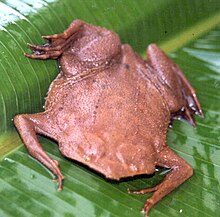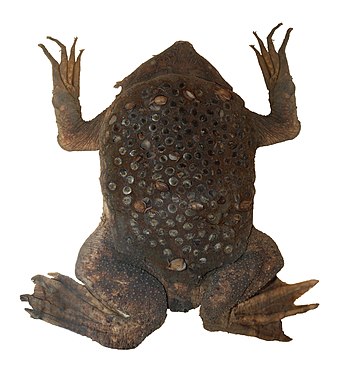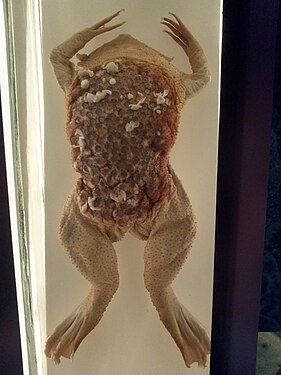Common Surinam toad
This article needs additional citations for verification. (October 2008) |
| Common Surinam toad | |
|---|---|

| |
| Scientific classification | |
| Kingdom: | Animalia |
| Phylum: | Chordata |
| Class: | Amphibia |
| Order: | Anura |
| Family: | Pipidae |
| Genus: | Pipa |
| Species: | P. pipa
|
| Binomial name | |
| Pipa pipa | |

| |
| Surinam toad range.[2] | |
| Synonyms | |
| |
The common Surinam toad or star-fingered toad (Pipa pipa) is a species of frog in the family Pipidae found in Bolivia, Brazil, Colombia, Ecuador, French Guiana, Guyana, Peru, Suriname, Trinidad and Tobago, and Venezuela. Its natural habitats are subtropical or tropical moist lowland forests, subtropical or tropical swamps, swamps, freshwater marshes, and intermittent freshwater marshes. It is threatened by habitat loss.
Description[]
The common Surinam toad is similar in appearance to a mottled brown leaf, and is almost completely flat. Its feet are broadly webbed with the front toes having small, star-like appendages. Males can grow up to 154 mm, whereas females can reach up to 171 mm. Females can not only be distinguished by their length, but also due to their ring shaped cloaca, visible when they are ready to breed.[3]
Their skin color is mostly light brown with some darker spots on the back,[3] so they can easily avoid predators.[4] The head of the Pipa Pipa has a very flat appearance and is triangular. It also has very small black eyes, that are located on the top of their head. These are not the only different characteristics, the toads have very long fingers that end in four star-shaped lobes.[4] The Surinam toad has no teeth and no tongue.
Behavior[]
The Suriname toad is found in slow-moving streams and rivers throughout South America.
Diet[]
The Pipa Pipa are omnivores, meaning that their diet consists mostly of invertebrates, such as worms, crustaceans and small fishes. The toad has sensory organs in the fingertips which help them catch their prey. [3]
Reproduction[]
Suriname toads are best known for their reproductive habits. Unlike the majority of toads, the males of this species do not attract mates with croaks and other sounds often associated with these aquatic animals. Instead, they produce a sharp clicking sound by snapping the hyoid bone in their throats.[5] The clicking sound of the Pipa Pipa toad resembles metallic noises. The average rate of these clicks is four clicks per second, consisting of blocks of 10 to 20 seconds per period. [6] Thereafter, the male will grab the front legs of the female, causing the clochea and the skin of the female to swell, this is called the amplexus. [7] The partners rise from the floor while in amplexus and flip through the water in arcs. The couple will swim around in the water until they have to swim to the surface to catch their breath. Afterwards, they will swim back down to the bottom of the water. There the male will lay on his back, with the female on top of him on her stomach. [8] During each arc, the female releases 3 to 10 eggs, which get embedded in the skin on her back by the male's movements, this can happen up to ten times. [7] After implantation, the eggs sink into the skin and form pockets over a period of several days, eventually taking on the appearance of an irregular honeycomb. The embryos develop through to the tadpole stage inside these pockets. The young Pipa Pipas grow a tail during their growth, however these will only be temporary because they will need the tail for inhaling oxygen. After 12 to 20 weeks, the young Pipa Pipas will hatch as small toads and they look identical to their parents. It takes a while for them to grow bigger since they are only 25 mm long when they are born. [3] Eventually emerging from the mother's back as fully developed toads. Once they have emerged from their mother's back, the toads begin a largely solitary life. After giving birth to the new toads, the mother slowly sheds the thin layer of skin that was used to birth them, and can begin the cycle again.
Gallery[]

The gray shape is the Surinam toad.

A Surinam toad with eggs embedded in the skin

Museum specimen

Museum specimen: closeup
Cultural significance[]
In a letter to the poet Samuel Taylor Coleridge writes “I envy dear Southey's power of saying one thing at a time in short and close sentences, whereas my thoughts bustle along like a Surinam Toad, with little toads sprouting out of back, side, and belly, vegetating while it crawls”.[9]
The Surinam toad is commonly cited as an example of a trypophobia trigger. [10]
References[]
- ^ IUCN SSC Amphibian Specialist Group (2015). "Pipa pipa". IUCN Red List of Threatened Species. 2015: e.T58163A61414791. doi:10.2305/IUCN.UK.2015-4.RLTS.T58163A61414791.en. Retrieved 18 November 2021.
- ^ IUCN (International Union for Conservation of Nature), Conservation International & NatureServe. 2010. Pipa pipa. In: IUCN 2015. The IUCN Red List of Threatened Species. Version 2015.2. "Archived copy". Archived from the original on 2014-06-27. Retrieved 2011-01-24.CS1 maint: archived copy as title (link). Downloaded on 10 July 2015.
- ^ a b c d Wandzel, Kathryn. "Pipa pipa". Animal Diversity Web. Retrieved 2021-11-30.
- ^ a b "Surinam toads, facts and photos". National Geographic. 2020-09-28. Retrieved 2021-11-30.
- ^ Piper, Ross (2007), Extraordinary Animals: An Encyclopedia of Curious and Unusual Animals, Greenwood Press.
- ^ Rabb, George B.; Snedigar, Robert (1960). "Observations on Breeding and Development of the Surinam Toad, Pipa pipa". Copeia. 1960 (1): 40–44. doi:10.2307/1439843. ISSN 0045-8511.
- ^ a b Whitefield, P. (1984). Encyclopedie van het dierenrijk - Alle gewervelde dieren in woord en beeld (in Dutch). Uitgeverij Areopagus. p. 472.
- ^ Preston-Mafham, Ken (1999). Frogs and Toads. Apple Identifier. p. 16.
- ^ Natali, Ilaria; Volpone, Annalisa (30 March 2016). Symptoms of Disorder: Reading Madness in British Literature, 1744-1845. ISBN 9781621967095.
- ^ "Do you have trypophobia? Unofficial phobia might make your skin crawl".
External links[]
 Data related to Pipa pipa at Wikispecies
Data related to Pipa pipa at Wikispecies Media related to Pipa pipa at Wikimedia Commons
Media related to Pipa pipa at Wikimedia Commons- Pipa pipa, at Animal Diversity Web
- IUCN Red List least concern species
- Pipa (frog)
- Amphibians of Bolivia
- Amphibians of Brazil
- Amphibians of Colombia
- Amphibians of Ecuador
- Amphibians of Guyana
- Amphibians of Peru
- Amphibians of Suriname
- Amphibians of Trinidad and Tobago
- Amphibians of Venezuela
- Amphibians described in 1758
- Taxa named by Carl Linnaeus




